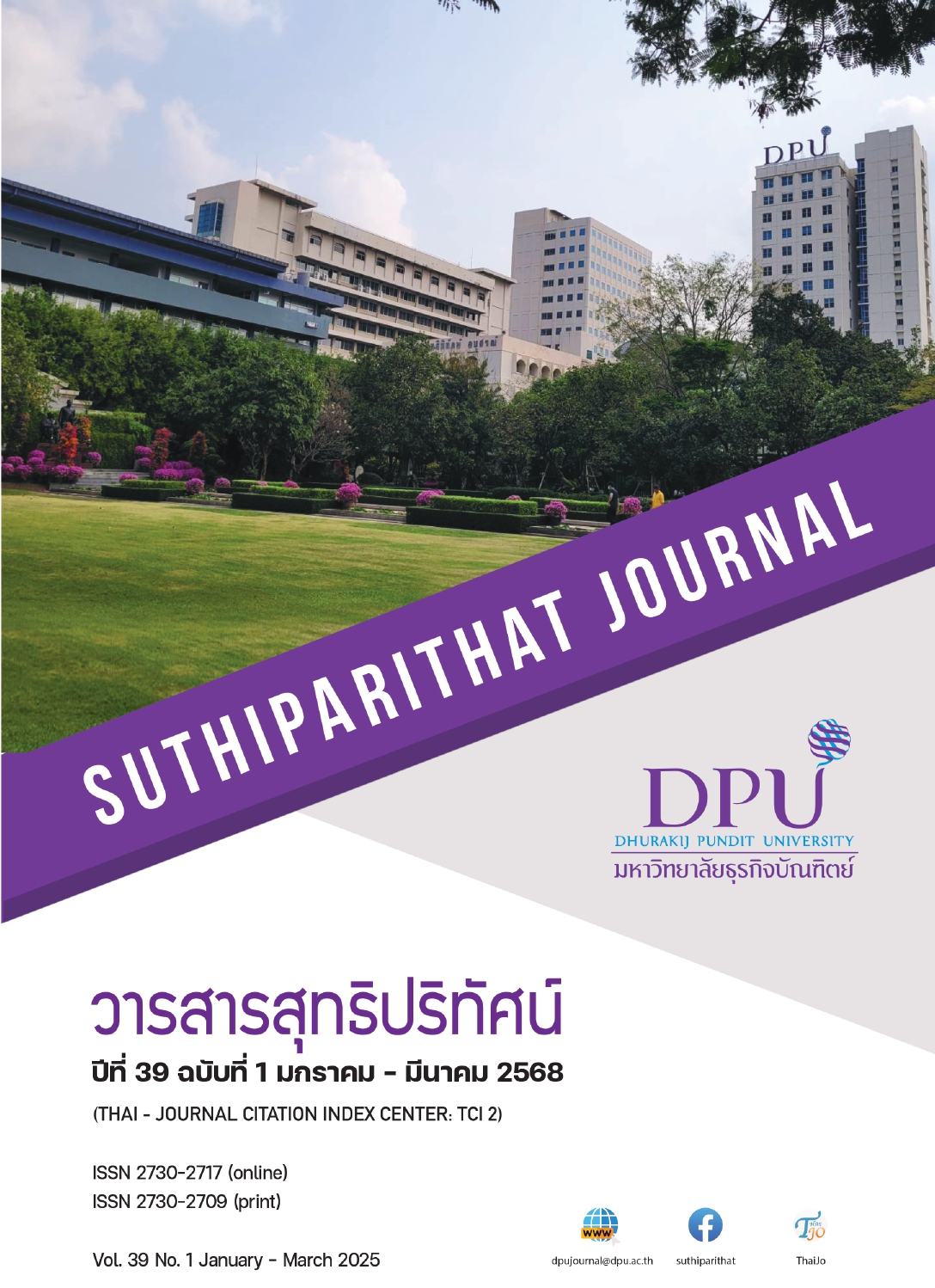องค์ประกอบการทำงานแบบมีส่วนร่วมของพนักงานใหม่ที่มีผลต่อพฤติกรรมการเป็นสมาชิกที่ดีขององค์การ
คำสำคัญ:
การทำงานแบบมีส่วนร่วม, พฤติกรรมการเป็นสมาชิกที่ดีขององค์การ, พนักงานใหม่บทคัดย่อ
งานวิจัยเรื่อง องค์ประกอบการทำงานแบบมีส่วนร่วมของพนักงานใหม่ที่มีผลต่อพฤติกรรมการเป็นสมาชิกที่ดีขององค์การ ในการศึกษานี้เก็บรวบข้อมูลโดยการแจกแบบสอบถามกับกลุ่มตัวอย่างที่เป็นพนักงานใหม่ จำนวน 370 คน วิเคราะห์ข้อมูลด้วยสถิติการวิเคราะห์การถดถอยพหุคูณ ผลการศึกษา พบว่า สมมติฐานได้รับการสนับสนุนบคือ องค์ประกอบการทำงานแบบมีส่วนร่วมของพนักงานใหม่ที่มีผลต่อพฤติกรรมการเป็นสมาชิกที่ดีขององค์การ อย่างมีนัยสำคัญทางสถิติที่ระดับ 0.001 ซึ่งเป็นที่น่าสังเกตว่า ตัวแปรองค์ประกอบการทำงานแบบมีส่วนร่วมที่มีผลกระทบต่อพฤติกรรมการเป็นสมาชิกที่ดีขององค์การมากที่สุดคือ ตัวแปร ความไว้วางใจ (Beta = 0.395) ตามด้วยตัวแปร ความยึดมั่นผูกพัน (Beta = 0.233) ตัวแปร การตั้งเป้าหมายและวัตถุประสงค์ (Beta = 0.157) และตัวแปร ความมีอิสระในการปฏิบัติงาน (Beta = 0.148) ตามลำดับ ผลการศึกษาครั้งนี้แสดงว่าองค์ประกอบการทำงานแบบมีส่วนร่วมทั้งหมดมีผลต่อพฤติกรรมการเป็นสมาชิกที่ดีขององค์การ แต่มีการประเมินในเชิงบวกที่ดีที่สุดคือ ความไว้วางใจมีผลต่อพฤติกรรมการเป็นสมาชิกที่ดีขององค์การ เพราะสำหรับพนักงานใหม่ ความไว้วางใจนั้นมีความสำคัญมาก เนื่องจากพวกเขาต้องเผชิญกับความท้าทายต่าง ๆ ในสภาพแวดล้อมการทำงานใหม่ ความไว้วางใจช่วยสร้างความปลอดภัยทางจิตใจที่ทำให้มีความกล้าที่จะริเริ่มและมีส่วนร่วมในพฤติกรรมการเป็นสมาชิกที่ดีขององค์การ เนื่องจากรู้สึกมั่นคงมากขึ้นในบทบาทของตนและได้รับการสนับสนุนจากองค์การและสมาชิกในทีม นอกจากนี้ การมีความไว้วางใจยังช่วยเพิ่มการมีส่วนร่วมในการทำงานของพนักงานใหม่โดยการลดความกลัวต่อการถูกลงโทษจากความผิดพลาดเล็กน้อย และเปิดโอกาสให้มีการสื่อสารอย่างเปิดเผย ซึ่งทั้งสองอย่างนี้มีส่วนช่วยเพิ่มระดับความพึงพอใจในงานและความมุ่งมั่นต่อองค์การ
เอกสารอ้างอิง
Allen, D. G. (2006). Do organizational socialization tactics influence newcomer embeddedness and turnover? Journal of Management, 32(2), 237-256. https://doi.org/10.1177/0149206305280103
Allen, N. J., & Meyer, J. P. (1990). The measurement and antecedents of affective, continuance and normative commitment to the organization. Journal of Occupational Psychology, 63(1), 1-18. https://doi.org/10.1111/j.2044-8325.1990.tb00506.x
Allen, T. D., Eby, L. T., & Lentz, E. (2006). Mentorship behaviors and mentorship quality associated with formal mentoring programs: Closing the gap between research and practice. Journal of Applied Psychology, 91(3), 567-578. https://doi.org/10.1037/0021-9010.91.3.567
Bakker, A. B., & Demerouti, E. (2008). Towards a model of work engagement. The Career Development International, 13(3), 209–223. https://doi.org/10.1108/13620430810870476
Deci, E. L., & Ryan, R. M. (1985). The general causality orientations scale: Self-determination in personality. Journal of Research in Personality, 19(2), 109-134. https://doi.org/10.1016/0092-6566(85)90023-6
Dirks, K. T., & Ferrin, D. L. (2002). Trust in leadership: Meta-analytic findings and implications for research and practice. Journal of Applied Psychology, 87(4), 611-628. https://doi.org/10.1037/0021-9010.87.4.611
Edmondson, A. (1999). Psychological safety and learning behavior in work teams. Administrative Science Quarterly, 44(2), 350-383. https://doi.org/10.2307/2666999
Gagné, M., & Deci, E. L. (2005). Self‐determination theory and work motivation. Journal of Organizational Behavior, 26(4), 331-362. https://doi.org/10.1002/job.322
Krejcie, R. V., & Morgan, D. W. (1970). Determining sample size for research activities. Educational and Psychological Measurement, 30(3), 607-610. https://doi.org/10.1177/001316447003000308
Latham, G. P., & Locke, E. A. (2007). New developments in and directions for goal-setting research. European Psychologist, 12(4), 290-300. https://doi.org/10.1027/1016-9040.12.4.290
Locke, E. A., & Latham, G. P. (1990). A theory of goal setting and task performance. Prentice Hall.
Locke, E. A., & Latham, G. P. (2002). Building a practically useful theory of goal setting and task motivation: A 35-year odyssey. American Psychologist, 57(9), 705-717. https://doi.org/10.1037/0003-066X.57.9.705
Mayer, R. C., & Davis, J. H. (1999). The effect of the performance appraisal system on trust for management: A field quasi-experiment. Journal of Applied Psychology, 84(1), 123-136. https://doi.org/10.1037/0021-9010.84.1.123
Meyer, J. P., Bobocel, D. R., & Allen, N. J. (1991). Development of organizational commitment during the first year of employment: A longitudinal study of pre-and post-entry influences. Journal of Management, 17(4), 717-733. https://doi.org/10.1177/014920639101700406
Meyer, J. P., & Herscovitch, L. (2001). Commitment in the workplace: Toward a general model. Human Resource Management Review, 11(3), 299-326. https://doi.org/10.1016/S1053-4822(00)00053-X
Organ, D. W. (1997). Organizational citizenship behavior: It's construct clean-up time. Human Performance, 10(2), 85-97. https://doi.org/10.1207/s15327043hup1002_2
Podsakoff, P. M., Ahearne, M., & MacKenzie, S. B. (1997). Organizational citizenship behavior and the quantity and quality of work group performance. Journal of Applied Psychology, 82(2), 262-270. https://doi.org/10.1037/0021-9010.82.2.262
Podsakoff, P. M., MacKenzie, S. B., Paine, J. B., & Bachrach, D. G. (2000). Organizational citizenship behaviors: A critical review of the theoretical and empirical literature and suggestions for future research. Journal of Management, 26(3), 513-563. https://doi.org/10.1177/014920630002600307
Saks, A. M., & Gruman, J. A. (2014). What do we really know about employee engagement? Human Resource Development Quarterly, 25(2), 155–182. https://doi.org/10.1002/hrdq.21187
Schaufeli, W. B., Salanova, M., González-Romá, V., & Bakker, A. B. (2002). The measurement of engagement and burnout: A two sample confirmatory factor analytic approach. Journal of Happiness Studies: An Interdisciplinary Forum on Subjective Well-Being, 3(1), 71–92. https://doi.org10.123/A:1015630930326
ดาวน์โหลด
เผยแพร่แล้ว
รูปแบบการอ้างอิง
ฉบับ
ประเภทบทความ
สัญญาอนุญาต
ลิขสิทธิ์ (c) 2025 มหาวิทยาลัยธุรกิจบัณฑิตย์

อนุญาตภายใต้เงื่อนไข Creative Commons Attribution-NonCommercial-NoDerivatives 4.0 International License.
เนื้อหาและข้อมูลในบทความที่ลงตีพิมพ์ในวารสารสุทธิปริทัศน์ ถือเป็นข้อคิดเห็นและความรับผิดชอบของผู้เขียนบทความโดยตรงซึ่งกองบรรณาธิการวารสาร ไม่จำเป็นต้องเห็นด้วย หรือร่วมรับผิดชอบใด ๆ
บทความ ข้อมูล เนื้อหา รูปภาพ ฯลฯ ที่ได้รับการตีพิมพ์ในวารสารสุทธิปริทัศน์ ถือเป็นลิขสิทธิ์ของวารสารสุทธิปริทัศน์หากบุคคลหรือหน่วยงานใดต้องการนำทั้งหมดหรือส่วนหนึ่งส่วนใดไปเผยแพร่ต่อหรือเพื่อกระทำการใด ๆ จะต้องได้รับอนุญาตเป็นลายลักษณ์อักษรจากวารสารสุทธิปริทัศน์ก่อนเท่านั้น







